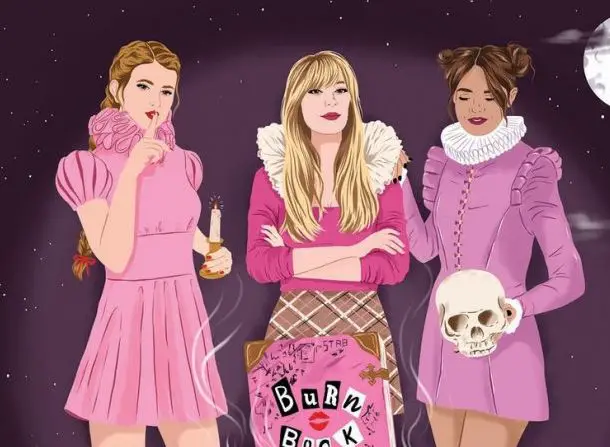“On Wednesdays, we array ourselves in pink!” That’s how the quote goes, isn’t it?
“Mean Girls” fans halt thy lives and get thee to a bookstore, because Cady Heron, Janis Ian, Damian and the Plastics are back in Ian Doescher’s latest film-to-play adaptation, “Much Ado About Mean Girls.”
The author’s latest retelling hit shelves this past April and has already gained momentum. Dressed in pink and featuring the infamous “Burn Book” on its cover, along with the Plastics, “Much Ado About Mean Girls” follows the same storyline of Tina Fey’s 2004 screenplay, though it takes the characters back to the Bard’s time.
The Portland-based writer is already well-known for his Shakespearean spin on George Lucas’ “Star Wars” films, which Quirk Books began to publish in 2014 and has continued to do so as films are released. The latest additions are “The Force Doth Awaken” and “Jedi the Last,” with characters depicted in period clothing on the covers. Paste Magazine has described the series as “brilliant” and received the compliment of being “a quirky addition to the genre-busting canon” by Entertainment Weekly.
“Much Ado About Mean Girls” joins “Get Thee Back to the Future!” in Doescher’s newest Pop Shakespeare series, the first set to focus on works other than Lucas’. What could be more fun than diving back into the intense world of young high school women, brutal clique rivalries and Burn Book-worthy betrayals?
It’s a Shakespearean comedy in disguise. With that being said, does this fun interpretation works the same as the film? Is Doescher’s version meant to be read as a parody or an ode?
Doescher’s acclaimed “William Shakespeare’s Star Wars” sets high expectations for “Much Ado About Mean Girls,” especially because the fan-favorite film remains at a fresh 84 percent on Rotten Tomatoes and its fans are constantly begging for a reunion film. Also, have you heard the soundtrack for the Broadway musical? It’s so fetch.
Like the film, Doescher’s play opens in Act 1 with protagonist Cady Heron explaining her home school circumstances, and begs that the audience “think not with prejudice upon [her] state, / For, truly, normal is [her] family,” as she prepares for her first day of public high school.
This scene is done via voice-over in the movie and it takes us through a montage of Cady’s life for the past 16 years. In the play, the monologue is used as an aside, a term used for when a character speaks and can be heard by the audience but not other characters. It translates well enough onto the page of a play and still does a great job of introducing a character without being disruptive.
The problem with translating a work from one medium to another is that not everything that worked well in the original can turn out well in the replica. When book rights are sold across the globe, translators are tasked with the daunting job of translating all aspects of the novel, even ones that are culture-specific.
The “Mean Girls” film continues to appeal to audiences because we find little pieces of ourselves in either the underdog, Cady, or relate to being friends with someone like Regina George. It’s a flawless formula that rarely fails.
This also works in Shakespeare’s most popular plays. Take “Romeo and Juliet,” which features characters from both the upper and lower class, for example. How many times have we seen this same formula repeated?
And while Shakespeare’s plays have been adapted countless times — who could forget Leonardo DiCaprio in Baz Luhrmann’s “Romeo + Juliet” — it mostly works because they are being adapted into contemporary settings. The characters that Shakespeare wrote influenced those we see today and we look for without even meaning to. There nearly always has to be a goofy best friend accompanying the handsome protagonist, such as Mercutio and Romeo.
The fact is that not everyone feels comfortable reading iambic pentameter for over 50 pages, and it can take a moment to decipher what is being said if you are not familiar with Elizabethan English.
I’ll admit that during my time reading the play, some of the jokes that are so obvious in the film were unrecognizable to me. In the film, when Cady spells out her name, Janis simply replies with, “Yeah, I’m gonna call you Caddy.”
Doescher’s translation takes a bit longer to get to the punch:
“JANIS: How dost thy spell thy name? Remind me, Caddy?
CADY: ‘Tis Cady—C-A-D-D-Y — by my troth.
JANIS: Well, for the nonce I still shall thee Caddy,
That thou mayst carry all my fondest hopes.”
It still remains a funny moment, if you can pick up quickly on what is happening in the character interactions without any help from the film. But the movie will inevitably be funnier because of the quick line delivery and the fact that if you’re not familiar with this form of English, it will take a moment to process it all.
Another interesting moment is when the revelation of the Burn Book causes the junior girls to go wild and attack one another, forcing Principal Duval to call an immediate gymnasium meeting. When Cady is walking to find a seat, she waves to Janis, who flips her off.
In Doescher’s script, instead of writing in that moment of Janis, it is made into an aside instead:
“Janis: [aside:] Who doth she think she is, to wave so fondly?
Wo doth she think we are, thus to forgive?”
Again, the execution falls a bit flat compared to the quick movements and reactions that are visible in the film.
Ultimately, Doescher’s re-vamping works because Shakespearean plays have always appealed to lovers of drama and tragedy. What greater audiences to sell this to than teenage girls?
Although “Much Ado About Mean Girls” has its own form of comedic value that differs from that of the film, it’s still a great addition to long-term fan, and worth a read.
















